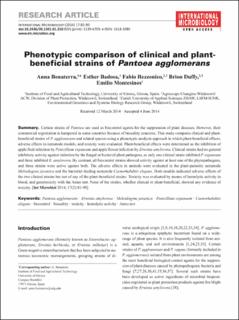Bitte benutzen Sie diese Kennung, um auf die Ressource zu verweisen:
https://doi.org/10.21256/zhaw-1490| Publikationstyp: | Beitrag in wissenschaftlicher Zeitschrift |
| Art der Begutachtung: | Peer review (Publikation) |
| Titel: | Phenotypic comparison of clinical and plant-beneficial strains of Pantoea agglomerans |
| Autor/-in: | Bonaterra, Anna Badosa, Esther Rezzonico, Fabio Duffy, Brion Montesinos, Emilio |
| DOI: | 10.21256/zhaw-1490 10.2436/20.1501.01.210 |
| Erschienen in: | International Microbiology |
| Band(Heft): | 17 |
| Heft: | 2 |
| Seite(n): | 81 |
| Seiten bis: | 90 |
| Erscheinungsdatum: | 2014 |
| Verlag / Hrsg. Institution: | Spanish Society for Microbiology |
| ISSN: | 1139-6709 |
| Sprache: | Englisch |
| Schlagwörter: | Biocontrol; Pantoea |
| Fachgebiet (DDC): | 570: Biologie |
| Zusammenfassung: | Certain strains of Pantoea are used as biocontrol agents for the suppression of plant diseases. However, their commercial registration is hampered in some countries because of biosafety concerns. This study compares clinical and plant-beneficial strains of P. agglomerans and related species using a phenotypic analysis approach in which plant-beneficial effects, adverse effects in nematode models, and toxicity were evaluated. Plant-beneficial effects were determined as the inhibition of apple fruit infection by Penicillium expansum and apple flower infection by Erwinia amylovora. Clinical strains had no general inhibitory activity against infection by the fungal or bacterial plant pathogens, as only one clinical strain inhibited P. expansum and three inhibited E. amylovora. By contrast, all biocontrol strains showed activity against at least one of the phytopathogens, and three strains were active against both. The adverse effects in animals were evaluated in the plant-parasitic nematode Meloidogyne javanica and the bacterial-feeding nematode Caenorhabditis elegans. Both models indicated adverse effects of the two clinical strains but not of any of the plant-beneficial strains. Toxicity was evaluated by means of hemolytic activity in blood, and genotoxicity with the Ames test. None of the strains, whether clinical or plant-beneficial, showed any evidence of toxicity. |
| URI: | https://digitalcollection.zhaw.ch/handle/11475/1709 |
| Volltext Version: | Publizierte Version |
| Lizenz (gemäss Verlagsvertrag): | CC BY-SA 3.0: Namensnennung - Weitergabe unter gleichen Bedingungen 3.0 Unported |
| Departement: | Life Sciences und Facility Management |
| Organisationseinheit: | Institut für Umwelt und Natürliche Ressourcen (IUNR) |
| Enthalten in den Sammlungen: | Publikationen Life Sciences und Facility Management |
Dateien zu dieser Ressource:
| Datei | Beschreibung | Größe | Format | |
|---|---|---|---|---|
| 2014_Bonaterra_Phenotypic comparison of clinical and plant-beneficial strains of Pantoea agglomerans_IntMicrobiol.pdf | 1.98 MB | Adobe PDF |  Öffnen/Anzeigen |
Zur Langanzeige
Bonaterra, A., Badosa, E., Rezzonico, F., Duffy, B., & Montesinos, E. (2014). Phenotypic comparison of clinical and plant-beneficial strains of Pantoea agglomerans. International Microbiology, 17(2), 81–90. https://doi.org/10.21256/zhaw-1490
Bonaterra, A. et al. (2014) ‘Phenotypic comparison of clinical and plant-beneficial strains of Pantoea agglomerans’, International Microbiology, 17(2), pp. 81–90. Available at: https://doi.org/10.21256/zhaw-1490.
A. Bonaterra, E. Badosa, F. Rezzonico, B. Duffy, and E. Montesinos, “Phenotypic comparison of clinical and plant-beneficial strains of Pantoea agglomerans,” International Microbiology, vol. 17, no. 2, pp. 81–90, 2014, doi: 10.21256/zhaw-1490.
BONATERRA, Anna, Esther BADOSA, Fabio REZZONICO, Brion DUFFY und Emilio MONTESINOS, 2014. Phenotypic comparison of clinical and plant-beneficial strains of Pantoea agglomerans. International Microbiology. 2014. Bd. 17, Nr. 2, S. 81–90. DOI 10.21256/zhaw-1490
Bonaterra, Anna, Esther Badosa, Fabio Rezzonico, Brion Duffy, and Emilio Montesinos. 2014. “Phenotypic Comparison of Clinical and Plant-Beneficial Strains of Pantoea Agglomerans.” International Microbiology 17 (2): 81–90. https://doi.org/10.21256/zhaw-1490.
Bonaterra, Anna, et al. “Phenotypic Comparison of Clinical and Plant-Beneficial Strains of Pantoea Agglomerans.” International Microbiology, vol. 17, no. 2, 2014, pp. 81–90, https://doi.org/10.21256/zhaw-1490.
Alle Ressourcen in diesem Repository sind urheberrechtlich geschützt, soweit nicht anderweitig angezeigt.